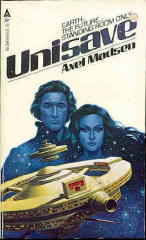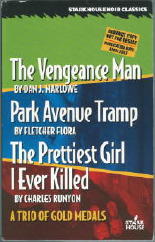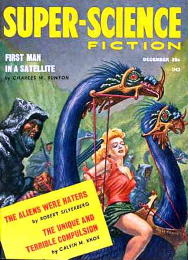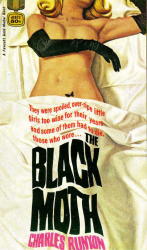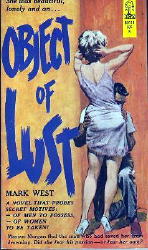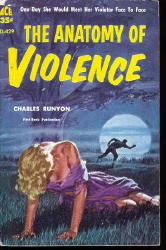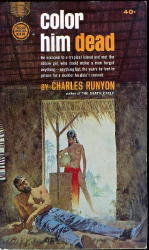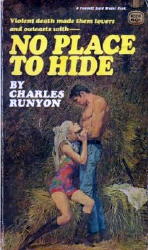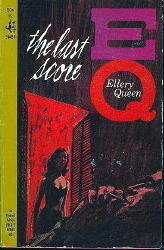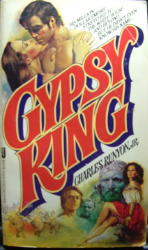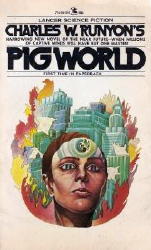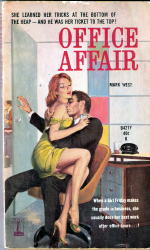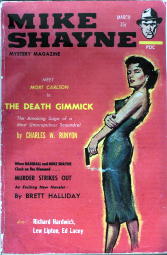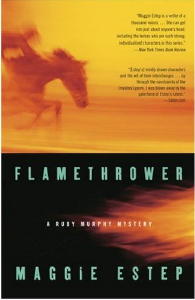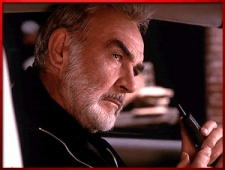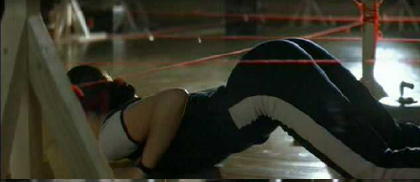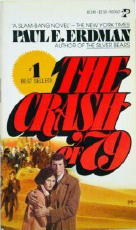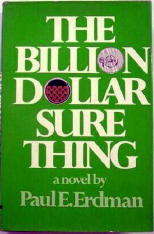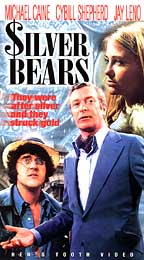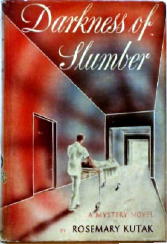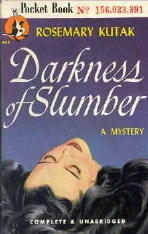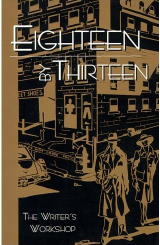April 2007
Monthly Archive
Mon 30 Apr 2007
As you probably know, a good many writers who are well-known in other fields other than crime and mystery fiction have, on occasion, produced books which fall into the category of interest to us here — even if you have to wrench the boundaries out of shape a little, à la Art Buchwald, whose passing was covered here earlier this year, as you may recall.
Axel Madsen, who died of cancer a week ago yesterday in California at the age of 76, is one of those authors. His entry in Crime Fiction IV, by Allen J. Hubin, is admittedly slim, but there it is nonetheless, and without the need for a stretch of any kind at all:
MADSEN, AXEL (1930-2007)
* Borderlines (New York: Macmillan, 1975, hc) [Mexico]
It is doubtful that Mr. Madsen made much money on the book, which will be returned to shortly. He began his writing career as a Hollywood film reporter in the 1960s and 70s, according to an obituary from the online edition of the Examiner, becoming famous if not wealthy by foregoing fiction and instead producing an eye-catching array of biographies of Hollywood stars, fashion designers, and other jet setters of the world.
Subjects of his books include Billy Wilder, John Huston, Coco Chanel, Barbara Stanwyck, Andre Malraux, Simone de Beauvoir, and John Jacob Astor, and the list is far from complete. According to the Examiner, who should know, “his most popular works, however, were salacious Hollywood fare such as Gloria and Joe: The Star-Crossed Love Affair of Gloria Swanson and Joe Kennedy in 1988 and The Sewing Circle: Female Stars Who Loved Other Women in 1995.”
It was Al Hubin who spotted Mr. Madsen as the author of Borderlines, the book largely taking place in Mexico. One webpage entitled Archaeology in Fiction Bibliography calls it a novel of stela smuggling.
Strangely enough, googling on the phrase “stela smuggling” brings up only the site already cited. It must not be a very common occupation, it is to be presumed, but it is still somewhat surprising that the profession has not been taken up more widely, considering that a stela is — among other possibilities — a “Maya stone monolith, frequently engraved with hieroglyphs.”
One online bookseller offering the book for sale describes it thusly: “A story of international smuggling for the highest of stakes: power and reputation. It is a fast-paced suspense novel that could be taken from today’s headlines – and one that ends with a cynical plot twist.” Right down our alley.
Borrowing again from the article in the Examiner: “Born in 1930 in Copenhagen to a Danish father and French mother, [Axel Madsen] grew up in Paris and worked for the New York Herald Tribune in the early 1950s.
“Following a stint with United Press International in Canada, he headed to Hollywood in the 1960s. There, he did publicity for movie studios and worked as freelance correspondent for various publications before dedicating himself full time to writing books.”
[UPDATE] 05-01-07. Excerpted from an email from Victor Berch, who also pointed out several typos, since fixed:
“Just read your obit notice on Axel Madsen. Am not sure whether you want to include his book: Unisave: Ace Books, [Feb] 1980. It is s-f, but deals with killing off the elderly population (what greater crime??).”
From the blurb on the cover: “In a dangerously overpopulated world the first line of defense has been breached. The birth quota had been a civilized measure: each adult had the right to replace himself with one child. Couples with two children reported to their local population care centres and were quietly restricted. But this had not stabilized the worlds population at 24 billion. Now, a harder less ‘civilized’ choice has to be made. The proposition — Geriatric Bingo — death for 1 in 3 amongst ‘eligibles’ in a standing room only world.”
Sun 29 Apr 2007
Stark House will publish its first three-fer this summer – three Gold Medal novels long in need of reprinting. I wrote the introduction to Charles Runyon’s The Prettiest Girl I Ever Killed, a masterful suspense novel that puts Runyon in the top ten of GM writers in such company as Lawrence Block, John D. MacDonald, Charles Williams, Vin Packer, Richard Stark, Malcolm Braly and a handful of others.
At the time I wrote the introduction I was told that Runyon was dead. Not so. He’s very much alive, and here’s an interview I recently had with him via email.
[Note: This interview previously appeared in three installments on Ed’s blog. Links at the end of this M*F blog entry will lead you to a complete bibliography of Charles Runyon’s fiction and an article he has written about a book that’s never been published, Dorian-7. — Steve]
● The obvious mystery to those who were following your career – when did you stop publishing and why?
In 1980, Jove published my novel,
The Gypsy King, which I thought represented my highest effort, a cut above the genre SF and mystery novels I had been publishing. I was never content with working at the level of my last published work, but at the same time I wasn’t sure which way to go with my future work. To fill in the time while deciding, I went back to the University of Missouri and picked up a Master’s in Creative writing, in case I might need to work before my sales picked up again.
However, the hiatus stretched on, and teaching did not blend with writing as well as I had hoped. Writing was still my preferred profession, but the path back to publishing was a rocky one, and nobody laid down a red carpet for me any more than they had at the beginning. Somehow the word got out that I had “passed on” in 1987, and the thought intrigued me, much as it once intrigued Tom Sawyer. What if I tried to reenter the field, not as an older writer reentering the field after a long lay-off, but as a fresh new face with reams of new ideas? However, thanks to you, Ed, that experiment has now been abandoned, or left to others to carry out.
● Can you give us a sketch of your life?
A rough sketch would show the young writer growing up on a farm in Worth County, Missouri, the most insignificant county in a not-too-significant state. I couldn’t wait to grow up and leave the farm like most boys, but ran away from home at age 16 to work on a ranch in West Texas.
So we come full circle; 60 years later I am back in Texas. The intervening years included army service in Korea, Germany and Indiana, J-school at Missouri University. I just missed a job on the National Geographic and instead went into industrial editing. It was either that or poetry which paid nothing. While working for Mr. Rockefeller’s old outfit in Chicago an agent to whom I had been paying readers’ fees for five years – Scott Meredith – suddenly started making sales.
I lost no time in quitting my job and announcing that I was now a full-time writer. With a new baby and no income, I borrowed a lakeside cabin and sat down to write my first book. After sending it off to my agent, I took off for the West Indies, found an almost deserted island, and lay back to await the gentle shower of royalties. It didn’t quite happen that way, but it was only a few months before the book sold to Ace; my reaction was to charter a yacht and take the wife and kid on a tour of the islands. I returned to New York suntanned but broke, still expecting the gilded life of a best-selling writer.
● How about a sketch of your publishing career? Was writing something you’d always wanted to do?
Since I was about 8 years old, and realized how easily (comparatively) words came to me. Before that I wanted to be a doctor, until somebody told me you had to go to school for endless years. I was already making preparations when in High School I took typing; the only other “boy” in my class was a pianist.
● Do you recall your first sale?
Of course; it was a short story called “First Man in a Satellite” to
Super Science Fiction in 1958 – almost fifty years ago! This was about the time the Russians sent up Sputnik so I was undeservedly credited with being a harbinger of the Space Age. I got a personal rejection from John W. Campbell [editor at
Astounding SF], with his signature slanting across the bottom of the page as if tracing the path of a tumbling tumbleweed. He disparaged the whole idea of a midget in a space ship, adding that Lester del Rey had already done it – better. Editors didn’t care about writer’s sensibilities in those days. I still treasure the letter.
● Which gave you more satisfaction as a writer – science fiction or crime novels?
It’s the sf novels and stories that I remember with the most affection. The crime stories and novels were more neatly wrapped up, while the sf novels and stories open onto worlds of other plot possibilities.
● What was the genesis of The Prettiest Girl I Ever Killed?
I was making notes for the book while spending the summer in my old home town of Sheridan, a place with an almost one-to-one correspondence to the Sherman of the book. The characters were pulled from the scenery of my past, specific incidents belonging to a real person could be welded to a fictional person without the need to improvise more than details of the plot. It was very liberating and exhilarating, to find that I could shape my own reality, as long as I kept it within the realm of the believable.
Actually, the story is not as bizarre as it may seem; my home town is near the little town of Skidmore, famed as the home of the hog-stealer, arch-bully, pedophile and murderer MacElroy, who was finally “executed” by a shotgun blast in full view of thirty townspeople. Not a single one of those citizens stepped forward to identify the shooter. Someday, I may get around to doing that book.
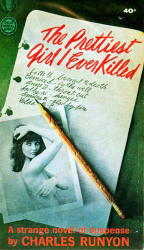
● Prettiest Girl is invariably likened to the novels of Jim Thompson but when I reread it recently my take was that there is a fundamental difference between your book and just about anything Thompson wrote. Your killer in control of himself – unlike many of the Thompson protagonists who seem hard-wired to be at the mercy of themselves – and he’s even a bit droll and sardonic at times. In other words, he can stand back and look at what he’s doing objectively.
The cumulative effect of this subtly but powerfully underscores his madness. Given the verities of paperback originals, this was an original approach. Did you think of it that way? Or are you even conscious of your writing decisions? Evan Hunter always said that he tried not to analyze what he was doing. He was afraid it would hamper his spontaneity.
I will have to read some of Jim Thompson before I comment on the difference between us. I always write in a close autobiographical style, even though I often change the pronouns to third person. When I finish a book, I always feel like a hollowed out lobster, all meat and flavor taken out, and nothing but dry pulp left inside.
That’s the reason I usually get in a few weeks of total leisure between novels; the creative energy needs time to rise to a level where I can begin pumping again. I think Evan Hunter is right in not analyzing his methods; the creative imagination is a shy, faery creature, and doesn’t like the cold light of appraisal.
● Sometimes you sound almost dismissive of your crime fiction. Your science fiction seems to be your true love. Are you unhappy when people say they prefer your crime fiction to your sf?
No, I just assume that these are non-sf-readers by nature. As long as I could treat these crimes as merely head games, I could get considerable pleasure out of working out the problems. Having been a police reporter, I had a good grasp of the routine and the jargon, as well as tons of material.
But I can date exactly when my preferences changed; in 1967 my younger brother was murdered, and the whole messy scene got involved with the stupidity of Vietnam and the decay of the courts, with the result that the murderer walked out of the courtroom smirking. This was too similar to the stuff I had been doing, and although I had many projects in the works, I never felt good about doing that sort of killer-oriented thing again.
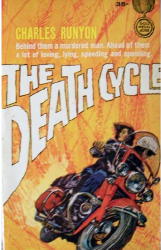
● You’ve written some of the most remarkable opening chapters in suspense fiction. The first five thousand words of The Dead Cycle, for instance, put me in mind of The Doors’ “Riders on The Rain.” Except that where the song is from the innocents’ point of view, this is from the Riders pov. There’s a mythic quality – almost of the old west – of the robbery gone wrong, an elderly clerk shot dead by one of the Riders, and them now desperately trying to get to the Mexican border.
This is so much more realistic than much of the neo-noir we see today because the turf is real and you know this turf, the small-town Midwest. But it’s the underbelly of the Midwestern small town you usually use. Was this intentional given that it’s the setting of so many of your Gold Medal novels?
Sometimes I wonder if I’m really a fiction writer. The motorcycle story was based on an unusual honeymoon my wife and I took, riding double on a Harley through the back roads of Mexico in 1957. Add another couple, a murder, a stash of cash and some loose gash and you get
The Death Cycle. It was fun to write, and to know that every bone-rattling jolt on that old Harley was paying off in hard core realism.
● The Black Moth, which is set on a college campus, is a notably different private eye novel in that the protagonist is a PI masquerading as a professor. But even here, in a more refined setting than you usually use, the writing stays hard as hell. Your books are proof that tough guys don’t have to swagger or be violent to prove that they’re tough. They’re hard asses and no less so when they don academic robes. Was Black Moth based on your early experiences teaching college courses?
At the time I wrote
The Black Moth I had never taught a college English course, but it definitely foreshadowed my later career. The idea was to have a series of vicious murders taking place amid the mannered politeness of an exclusive girl’s finishing school. And in Columbia Missouri, where I did my journalism study, there was Stephens College, the very model of such a school. My undergraduate years of dating Stephens girls paid off in some interesting characters and loads of verisimilitude. One of the fallacies of the lay person is that you can “create” characters out of whole cloth. With me, it’s more of a cut-and-paste.
● What was your best career experience?
Winning a nomination for the Edgar Allan Poe award of the MWA for
Power Kill.
● What was your worst?
Having Lancer Books go belly-up just after publishing my novel of the occult,
Dorian-7. I wish I’d been warned about their shaky finances. I wrote an article on the subject, “The Curse of Dorian-7,” but I never tried to get it published. [The article appears
here, its first time in print.]
● You mentioned that you’ve been writing a science fiction trilogy. Have you given any thought to a crime novel?
Many thoughts, backed up by notes, bits of dialogue, and in a few cases, almost-finished works that never quite made it to the marketplace. I’ll take another look at the material and see what I have that is timely and appropriate, if you’re interested in looking at it.
● Do you read contemporary writers? If so, name a few you feel are notable.
I read Stephen King’s
Cell, on the recommendation of my students, and found it admirable in many ways, but to me the most nearly perfect practitioner of the horror field is Peter Straub.
Houses without Doors is my most recent sampling, but my all-time favorite is
Ghost Story. I also enjoyed
Superstition.
John Updike’s suspense novel, The Terrorist, brings out his talent for deft characterization and subtle plot turnings, as well as being as timely as the morning paper. John Grisham is another old-timer who’s still eminently readable; The Painted House is one I recommend. Taking the whole field as my bailiwick, I’ll mention Trial, by Clifford Irving, Skins of Dead Men by Dean Inge, and Acceptable Losses by Irwin Shaw. I’d also recommend The Greenlanders by Jane Smiley. Though it’s not a genre novel, it’s a fascinating story and well-written.
● Which of your novels would you most like to see reprinted and why?
There are at least three that might go down well with today’s readers.
The Last Score was rushed to completion as a work-for-hire, for Manfred Lee and Fred Dannay, and published under their byline of Ellery Queen. I still have a paternal affection for the book, and would like to see it reprinted under it’s “rightful” parentage.
Also, there was one I wrote under the nom de plume of Mark West, which was published under the unforgettable title: Object of Lust. Another rush job, done to the background music of a wolf growling outside the door, but I think it’s worthy of another shot at the gold ring. If you recall the old limerick beginning: “There once was a hermit named Dave …” you’ll have an idea of what it’s about. And finally there’s my first one, The Anatomy of Violence, which still holds my interest despite a klutzy romantic element.
—
Charles W. Runyon: A Bibliography
The Curse of Dorian-7
Sun 29 Apr 2007
For a version with many more cover images, please see the main M*F website.
[UPDATE] 05-18-07. The link above is now the location of the “official” bibliography. It contains the additions made today and not found below. Any additional corrections will also be made to only the one found on the main M*F website.
As Charles Runyon:
# The Anatomy of Violence (n.) Ace D-429, pbo, 1960 “One day she would meet her violator face to face.”
# The Death Cycle (n.) Gold Medal s1268, pbo, January 1963. “Behind them a murdered man. Ahead of them a lot of loving, lying, speeding and spending.
# Color Him Dead (n.) Gold Medal k1320, pbo, July 1963 [Caribbean] “He escaped to a tropical island and met the native girl who could make a man forget anything – anything but the years he lost in prison for a murder he didn’t commit.”
= Reprinted as The Incarnate, Manor Books 15235, pb, 1977. “There was nothing she would not do to make him forget.”
# The Prettiest Girl I Ever Killed (n.) Gold Medal k1507, pbo, 1965. “A strange novel of suspense.”
# -Bloody Jungle (n.) Ace G-594, pbo, 1966 [Viet Nam], as by Charles W. Runyon. “A powerful novel of the Green Berets in Vietnam.”
# The Black Moth (n.) Fawcett Gold Medal d1873; 1967 [Illinois] “They were spoiled, over-ripe little girls too wise for their years and some of them had to die, those who wore … The Black Moth.”
# No Place to Hide (n.) Gold Medal R2218, pbo, 1970. “Violent death made them lovers and outcasts with – No Place to Hide.” [Robert McGinnis cover]
# Power Kill (n.) Gold Medal T2560, pbo, May 1972. “First-rate suspense … compellingly readable.” — Mario Puzo.
# Something Wicked (n.) Lancer 1973.
—
UPDATE from Charles:
Something Wicked was apparently the title put on
Dorian-7 by the inheritors (if that is the right word) of the Lancer properties. [This makes this the book that Lancer paid for but never published before they went out of business. For more on the “curse” on this book, Charles has much more to say
here.]
# To Kill a Dead Man (n.) Major 3061, pbo, 1976 [Caribbean] “He was an assassin for hire – no assignment was too large!”
—
UPDATE from Charles:
A Killer is a Lonely Man was my title for this novel. [The latter title appears in some bibliographies as an unpublished book that Charles wrote.]
# Kiss the Girls and Make Them Die (n.) Pyramid 03963, pbo, 1977, as by Charles W. Runyon. [Hospital] “In the sterile white corridors of a mental ward – and the unexplored passages of the mind – unfolds a novel of heart-clutching terror, with a cast of characters caught inextricably in its lurking mystery.”
As Ellery Queen
# The Last Score (n.) Pocket Books 50486, pbo, November 1964. Signet Q6102; pb, Oct 1974 [Mexico] (Rich couple’s daughter is kidnapped under the nose of her travel agent chaperone Reid Rance while on vacation in Mexico, and he’s got to get her back.)
# The Killer Touch (n.) Pocket Books 50494, pbo, October 1965. Signet Q6514, pb, 1975. [Caribbean] “There are many ways to die, sometimes nature holds the most special ones.”
# Kiss and Kill (n.) Dell 4567, pbo, April 1969. [Mexico] “The lady was luscious, and death followed everywhere she went.”
As Charles Runyon, Jr.
Gypsy King (n.) Jove 04041, pbo, 1979. Historical Romance. “His million dollar empire stretched to the White House and beyond, but he didn’t even know his name.”
As Charles W. Runyon
Pig World (n.) Doubleday, hc, 1971. SF.
= Lancer 75446, pb, n.d. “Charles W. Runyon’s harrowing new novel of the near future – when millions of captive minds will have but one master!”
Ames Holbrook, Deity (n.) Curtis 07202, pbo, 1972. SF.
Soulmate (n.) Avon 18028, pbo, March 1974. Horror. Expanded from the story “Soulmate” Magazine of Fantasy & Science Fiction, April 1970. “A contemporary horror tale & a strong one, not recommended for the squeamish.”
I, Weapon (n.) Doubleday, hc, July 1974. SF.
= Popular Library 04127, pb, December 1977. “He was the ultimate man – and humankind’s last hope for survival.”
As Mark West
Office Affair (n.) Beacon B-421Y, pbo, 1961. “She learned her tricks at the bottom of the heap – and he was her ticket to the top!”
His Boss’ Wife (n.) Beacon B-466F, pbo, 1962. “He was a man on the make and this time he wanted – his boss’ wife.”
Object of Lust (n.) Beacon B-468F, pbo, 1962. “She was beautiful, lonely and an … object of lust.”
●● Asked about the criminous content of the Mark West books, here’s what Charles had to say:
“Crime in the Beacon books? In
Object of Lust, Lewis stalked the woman and then kidnapped her and held her prisoner in a cave. (The setting is Branson, Mo, famous for caves and country music.)
“His Boss’ Wife involves a traveling maggie crew run by a dominant male who intimidates his females into doing his will, and controls the young males by parceling out the favors of his harem. Crimes abound, since these maggies are always on the line between fraud, larceny, breaking and entering, flirting daily with accusations of rape and assault.
“I still have these kids coming to my door and delivering the same sales pitch I used to hand out back in ’50 when I did my tour as a maggie. Sex predominates, because the editor had a feeling that readers wouldn’t stick past page 38 unless they read at least one explicitly graphic sex act. For me the important element was the tribal conflict between The Old Man and the brash upstart who joined the crew one morning in Minneapolis.
“In Office Affair, the crime was Insider Trading, which landed Milliken and several others in the slammer. Involves the aggressive young CEO of Wolverine Pipeline Co and his lovely Chief Stockholder, who fight off a hostile takeover while enjoying a sex-romp around the executive suite.”
Mystery and Suspense Stories
“Hangover Manhunt” Manhunt, December 1960
“The Last Kill” Manhunt, April 1961.
—
UPDATE from Charles: “Rum and Chaser” was the title put on this story by Scott Meredith (or somebody working there at the time; perhaps Terry Carr) but that didn’t go down with the editor of
Manhunt, who replaced it with my original title, “The Last Kill.”
“The Possessive Female” Manhunt, June 1961
“Sales Pitch” (by Mark Starr) Manhunt, June 1961
“The Death Gimmick” Mike Shayne Mystery, March 1962
“The Waiting Room” Alfred Hitchcock Mystery, October 1969
“Cycle Death Run.” Men, April 1970 (**)
“The Dead Survive” Mike Shane Mystery, September 1974
“A Good Head for Murder” Alfred Hitchcock Mystery, November 1974
“The Company of Brave, Rich Men” Alfred Hitchcock Mystery, April 1975
“An Act of Simple Kindness” Mike Shane Mystery, November 1975
“Death Is My Passenger” Mike Shayne Mystery, June 1976
(**) Since this magazine is probably the most difficult of Charles’ appearances in print to come by, here courtesy of the Internet, is a summary of the story line:
“Cycle Death Run” concerns two bikers on the lam who trade wives in an effort to preserve the peace. Jeanne slowly falls in love with Carl for unexplained reasons. It may be because he does not beat her, or it may be because he awakens her as a women. More likely the motivation is not important to the story. Carl is a man, self–confident and self–reliant. He does not have to beat his women, though Jeanne wishes he would: “She almost hoped he would knock her down and beat her, for it would help assuage her own guilt. ‘I won’t be this foolish again,’ she said.” That she would love him is natural. “Cycle Death Run” ends with the unlikely image of Carl and Jeanne in paradise.
Science Fiction and Fantasy
“First Man in a Satellite” Super Science Fiction, December 1958
“Solution Tomorrow” Fantastic, September 1959
“Remember Me, Peter Shepley” Fantastic, December 1960
“Happiness Squad” Fantastic, March 1967
“The Youth Addicts” Worlds of IF, May 1967
“Sweet Helen” Magazine of Fantasy & Science Fiction [F&SF], September 1969
“Dream Patrol” F&SF, February 1970
“Soulmate” F&SF, April 1970. Expanded into the novel Soulmate (Avon, pbo, 1974)
“Once There Were Cows” F&SF, July 1974
“Noomyenoh” F&SF, January 1975
“Terminal” F&SF, August 1975
“In Case of Danger, Prsp the Ntxivbw” F&SF, December 1975
“Brain Diver” F&SF, March 1976
“The Sitter” F&SF, July 1976
“Daughter of the Vine” F&SF, April 1977
“Metafusion” Stellar 3: Science Fiction Stories, Judy-Lynn Del Rey, ed. (Ballantine/Del Rey, pbo, October 1977)
“The Liberation of Josephine” F&SF, September 1978
– The basis for this bibliography was Crime Fiction IV, by Allen J. Hubin, and the records of Charles Runyon. Thanks also to Bill Crider and Charles Runyon for providing many of the cover images seen on this page.
—
Ed Gorman interviews Charles Runyon
The Curse of Dorian-7
Sun 29 Apr 2007
Posted by Steve under
Authors ,
ReviewsNo Comments
MAGGIE ESTEP – Flamethrower
Three Rivers Press; trade paperback. First Edition, September 2006.
This is the third in Maggie Estep’s Ruby Murphy mystery series, and as usual, I came in late. The first two were Hex (Three Rivers, March 2003) and Gargantuan (Three Rivers, July 2004), and while I’ve been meaning to – and I haven’t yet – my intentions are to get my hands on the first two as soon as possible.
If I thought that Doug Swanson’s Dreamboat was somewhat over-the-top and humorous, and I did, I certainly didn’t see this one coming. Ruby Murphy, who lives as low-key and laid-back a life in Brooklyn and environs (post-Giuliani Manhattan, Queens, Coney Island) as anyone possibly could, begins this episode with a visit to her psychiatrist, Dr. Jody Ray. Ruby has been seeing Jody since the death of someone she cared about – well, Attila, her lover – in a previous book. Unfortunately, not having read the previous book, this did not mean a lot to me, personally, but having a sociopath murder someone close to you right before your eyes, I grant you, maybe a psychiatrist could help.
And Ruby’s new boyfriend is obsessed by a new object of his affection, his new horse, making this her primary complaint to Jody during this particular visit. Which is summarily interrupted when Ruby discovers, you will not believe this, one of Jody’s husband’s legs in the fish tank outside her office.
That’s when you know that you have a story that has gone completely off the tracks, and in fact there are no tracks in sight. Where, oh where, you could most reasonably ask, could a story possibly go from here? The quote above came from only page 11 and continues thusly:
Ruby started wishing she were home, in bed, with the covers pulled over her head. Instead, she was standing there, watching her psychiatrist vomit. Dr. Jody Ray had evidently eaten Chinese food for lunch.
Eventually, a few twists and turns of the plot later, Ruby is hired (after being mysteriously (and falsely) fired from her job at the Coney Island Sideshow Museum) to find the missing doc, who seems to have a past history that Ruby knew nothing absolutely about, including (page 211) the aspect of the previously mentioned past from which the title of the story arises.
That the last 12 pages have nothing to do with the mystery end of things tells you something about where the priorities lie in the Ruby Murphy mysteries: not all that so very high. And truth be told, mystery-wise you will have had to have read the other two books to reap all you should from this one. The last chapter is about Ed, the new boyfriend, who became somewhat estranged from Ruby partway through this one, and Ed’s new horse, and Ruby’s new dog Spike.
That you might not care (that the last 12 pages have nothing to do with the mystery end of things) – and I didn’t – shows you what kind of writer that Maggie Estep is, and how finely etched her characters are. Or, on the other hand, you being you and not me, it might do absolutely nothing of the kind.
Sun 29 Apr 2007
ENTRAPMENT. 20th Century-Fox, 1999. Sean Connery, Catherine Zeta-Jones, Ving Rhames, Will Patton. Rating: PG-13. Director: Jon Amiel.
I have listed four actors in this movie, and while the last two of the four have small but significant roles to play, the fact of the matter is that this is a two-star picture — Sean Connery and Catherine Zeta-Jones — and no one else matters very much at all. One or the other is on the screen, let’s say about 99% of the time, and often both. If for some reason you have an aversion to either one, and I don’t see possibly how, but OK, I’ll concede it, then this is not the movie for you.
Storyline: Virginia Baker (Catherine Zeta-Jones) works for an insurance company specializing in security. Robert MacDougal (Sean Connery) is an art thief.
Um. Do you need more than that? Of course there’s more. This is a caper movie, one with many, many intricate plans for stealing things, and getting away with it, and yes, they are working together on almost all of them, for reasons that are complicated and you don’t want to know about them before you watch this movie anyway.
A question though: If you are forced to go along with a theft — you know, incriminating photos or the like — is that entrapment or blackmail? I thought so.
Many of those leaving comments on IMDB mention the lack of chemistry between Gin and Mac, or the actors who play them. Nonsense, I say. Utter nonsense. One of Mac’s rules is that there be no romantic involvement between partners in the crimes he commits, and he is sorely if not wistfully tempted to break it; and it is clear — well, as clear as anything is clear in this small masterpiece of role-playing, we know she is playing a role, but what role is not so clear — that she returns the feeling. Those IMDB viewers must have been very young.
At the age of 30, Catherine Zeta-Jones may have been at the peak of her youthful beauty — slim and lithesome and fair of face — when she made this movie. At the age of 69, Sean Connery is as handsome as ever, mismatched in terms of age, perhaps, but most definitely not in terms of the fire within.
Sat 28 Apr 2007
EDWARD S. AARONS – Assignment–Stella Marni
Gold Medal 666; paperback original. First printing, April 1957. Reprinted several times: as 906 (2nd pr., 1959), k1515 (4th pr., 1965), d1729 (5th pr., 1966), T2308 (6th pr., 1970), and M2949 (1973).
Search as I may, I cannot determine what the number and date of the third printing might be. Although, of course, I fully realize that I may be the only person reading this who may care. The data as given above may also be suspect, it is true, determined as it was largely from listings on ABE and elsewhere, which is hardly the most reliable way of doing bibliographic research.
But one thing that is clear is that the book, published as the fourth in the Sam Durell “Assignment” series, came out early enough to be reprinted again and again as later ones came along. (In the same way the the oldest child in the family gets the vast majority of the appearances in the family’s photo album.) What is not so obvious from the bibliographic data is that the book is not among the better ones in the series.
At first I thought that this may have been due to the fact that the action takes place solely in the five boroughs of New York City. It’s been a while since I read one of the books in the series, but what I remember always enjoying is Aarons’ detailed descriptions of the exotic places of the world where he would place Durell next. But that’s not really the problem Even this early in the series Aarons shows how he could make even the most mundane places suddenly come to focus, and with a fresh perspective. Here, for example, is Sam on page 87 as he is tracking down a frightened girl’s father – well, all right: Stella Marni’s father – who has been kidnapped and may be hidden away on a freighter docked along Manhattan’s west side:
… She was a frightened girl hiding behind her mask of cool and impersonal detachment. He knew her now. And he knew she was not the proud goddess disdainful of men, the remote and chilling woman she had seemed to be.
He pushed her aside in his mind with a deliberate effort. Nobody had challenged him in the busy shed, where he wandered alongside the white, rust-flaked plates of the freighter. An officer on the bridge was shouting something down to the longshoremen astern, his voice garbled and echoing through a hand amplifying phone. Most of the loading was being done through the cargo hatches aft of the center superstructure. But there were two loading ports in the side of the ship open to gangways nearby. So far as Durell could see, no one was on guard, and several men came and went on errands by that route, to and from the ship.
He walked that way. He had no longshoreman’s badge authorizing him to be here, and he could be challenged at any moment …

Stella Marni is a crucial element in a campaign by several communist countries to “call home” refugees who’ve come to the United States seeking political asylum. Convinced that all is well back in their native land, several such people have gone back, only to never to be seen again. As a famous successful photographic model, Stella Marni has gone before a Senate committee stating her willingness to return to her native Hungary. Sam wonders why, and if there is any way to change her mind. The final key to her mysterious change of heart: her missing father.
Stella is also one of those women who draw men to her like the proverbial moths to a flame, and even Sam may not be immune. On pages 72-73 he has a long and increasingly bitter confrontation with his close lady friend Deirdre, who, although she herself asked Sam to help Stella in the beginning, is also beginning to have second thoughts. As it has transpired, Sam has spent the previous night with Stella, causing Deirdre to become suspicious and increasingly jealous. And even though the night spent together by Sam and Stella was innocent enough, the fact remains that Deirdre has every right to be.
The primary focus of this tale is therefore Stella: as an enchantress, as a unwitting Jezebel, and yet as an innocent victim. And if you are beginning to wonder if this makes the book a “cozy” in any sense of the term, the answer is no. There are some extremely tough fight scenes in this book also, one example of which is on page 127. (Severely tempted to add quotes both here and up above a paragraph, I decided to reconsider when I looked and saw just how long each of the insertions would have to be, in order to convey the full effect.)
And this is strange. As I am typing up my comments on the book just now, based on the notes that I took (over a month ago) I am suddenly discovering that I may have liked the book more than I thought I did. But no, it is not so. The last comment I see that I made is that it is “lightweight at the core.”
Which meant at the time, and still so now, that there are no twists or surprising turns of the plot. Paths I anticipated did not occur, even the less imaginative ones. The story has but one direction to go, and that it does so with skill – and a modicum of finesse – still does not mean that it is not going in any more than in one direction.
Postscript: I wonder somewhat about Deirdre. Being the girl friend of an ruthless CIA agent whose jobs continue to take him to exotic places around the world, places in which equally exotic women are always available and/or near at hand, would hardly seem ideal for a long-lasting relationship. The future for her appears rather blaak and dismal. All seems well again at the end of this book, but just how long, I wonder (that is to say, for how many more books) does Deirdre manage to stick it out? Anyone know?
Fri 27 Apr 2007
Malcolm Sage, detective, created by author Herbert Jenkins, is one of the few fictional characters who are covered in both Kevin Burton Smith’s
Thrilling Detective website dedicated to Private Eye fiction, and Michael Grost’s
Guide to Classic Mystery and Detection website dedicated to precisely that.
Kevin leads off his comments by saying: “Malcolm Sage had been a hot shot intelligence agent for Britain’s Division Z during the Great War, but when the fighting ceased, his thirst for action and adventure didn’t. Fortunately, his old chief from Division Z helped him set up the Malcolm Sage Detective Bureau, and much merry mayhem and more than a few ripping good yarns ensued.”
Says Mike, in part: “Jenkins’ work has some similarities to R. Austin Freeman’s. Malcolm Sage, like Thorndyke, is a private investigator; he is hired by the insurance companies, similar to the arrangement in Thorndyke’s books. Sage, like Thorndyke, emphasizes photography in his work. He is also skeptical of fingerprints. Most of the clues he follows up on in his cases fall within the parameters of Freeman’s world.”
Besides the stories collected in the volume Mary reviews below, Malcom Sage appeared a year earlier in a novel entitled John Dene of Toronto; A Comedy of Whitehall (Herbert Jenkins Ltd, London, 1920; George H. Doran Co., New York, 1919). Another short story is included in the collection The Stiffsons, and Other Stories (Jenkins, 1928). (Strangely enough, no source seems to know which one it is.) Herbert Jenkins the publisher was the also Herbert Jenkins the author, in case you were wondering.
A complete bibliography for Herbert Jenkins the author can be found online, many of his novels chronicling the humorous adventures of the Bindle family.
— Steve
HERBERT JENKINS – Malcolm Sage, Detective
Jenkins, 1921; Doran, 1921. The complete contents are as listed below, as given in Crime Fiction IV, by Allen J. Hubin. Some of these are apparently bridging episodes only and not complete stories in themselves.
• Gladys Norman Dines with Thompson • ss
• The Great Fight at the Olympia • ss
• The Gylston Slander • ss Hutchinson’s Story Magazine Jul ’20
• The Holding Up of Lady Glanedale • ss
• Inspector Wensdale Is Surprised • ss
• Lady Dene Calls on Malcolm Sage • ss
• A Lesson in Deduction • ss
• Malcolm Sage Plays Patience • ss
• Malcolm Sage’s Mysterious Moments • ss
• The Marmalade Clue • ss
• The McMurray Mystery • ss
• The Missing Heavyweight • nv
• The Outrage at the Garage • ss
• Sir John Dene Receives His Orders • ss
• The Stolen Admiralty Memorandum • nv
• The Strange Case of Mr. Challoner • ss
• The Surrey Cattle-Maiming Mystery • ss
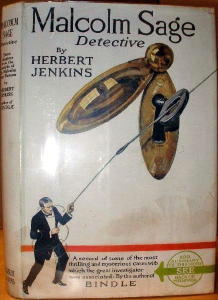
Malcolm Sage was an accountant who was always finding “little wangles” in the books. Refused for war service by the army, he worked for the Ministry of Supply and found a much larger wangle, eventually transferring to Department Z in Whitehall. The department handled secret service work during the war and now the conflict is over and the Department is being demobilised, Sir John Dene, his old chief, agrees with Lady Dene Sage that Sage should be set up in a private detective agency.
Sage has a “bald, conical head”, a “determined” jaw, and protruding ears. His keen gaze is aided by gold-rimmed spectacles and his “shapely” hands are always restless, drawing on his blotting pad, balancing a spoon on a knife, constructing geometrical designs with matches, that sort of thing. He is kind, quiet, and never smiles. Nevertheless Sage’s Whitehall staff is devoted to him and it is from their ranks he chooses a handful to work at his agency. Gladys Norman will continue as his secretary and other departmental personnel engaged for the new venture are Sage’s assistant James Thompson, office junior William Johnson, and chauffeur Arthur Tims.
● This collection of investigations kicks off with “The Strange Case of Mr Challoner,” who was found an apparent suicide in a locked library. However, foul play is suspected and Richard Dane, Mr Challoner’s nephew is fingered as the likely culprit, having violently quarreled with the dead man the day before.
● In “The Surrey Cattle-Maiming Mystery,” Sage is called in to hunt down the person responsible for the crimes. There had been almost thirty going back over two years, despite villagers organising a committee to keep watch at night. Peppery General Sir John Hackblock, whose mare has been similarly mutilated, asks Sage to look into the matter since he is not satisfied with what he was told when he consulted Scotland Yard.
● “The Stolen Admiralty Memorandum” opens with a summons to a country mansion where the Prime Minister, the First Lord of the Admiralty, and the Secretary of War are both weekend house guests – and all are in a panic. The memorandum has disappeared and could do a great deal of damage in the wrong hands. Who is responsible for its theft? There are plenty of suspects, including over a dozen house servants and a number of other guests along with their ladies’ maids and valets.
Next we have an interlude in which secretary “Gladys Norman Dines with Thompson,” Sage’s assistant. Gladys debates why the staff is so loyal to their employer, with a nice little sideswipe at expectations raised by romance novels (E. M. Hull sprang to mind!). Their conversation explains how Gladys came to work for Sage and where Thompson first met their employer, fleshing out the lives of the bureau employees as also happens elsewhere. The reader never has the impression the staff are spear carriers whose role is to admire Sage’s brilliance, and learning something of their lives was an attractive sidelight.
● Then it’s back to criminous business with “The Holding Up of Lady Glanedale,” wife of margarine magnate Sir Roger Glanedale. She has been robbed at gun point in a nocturnal burglary at the family’s country house. The Twentieth Century Insurance Corporation Limited calls Sage in to investigate the circumstances and find the missing jewelry.
● “The McMurray Mystery” deals with Professor James McMurray, found murdered in a locked laboratory. It is a particularly mysterious matter because the body of the professor displays a strangely youthful appearance. McMurray’s friend and philanthropist Sir Jasper Chambers was the last person to talk to the professor, who was in the habit of living in his laboratory for days on end and refusing to admit anyone for any reason. How then did his murderer get
in and out and what is the role of marmalade in the affair?
● A flurry of scandalous poison pen letters allege a vicar’s daughter and his curate are carrying on an intrigue. Naturally these foul communications cause much distress and agitate the villagers of Gylston and its surrounding area. “The Gylston Slander” sees Sage called in to find the culprit.
● Charley Burns is “The Missing Heavyweight,” who disappears on the eve of an important fight on which many have wagered large sums. Where has he gone and why? Was he taken ill, kidnapped, or did he run away, afraid to fight? This particular entry includes an excellent example of Sage’s deductions from evidence, in this case a patch of garden soil. Unlike some of the more startling deductions made by Holmes, here as in other stories the detective’s explanations seem reasonable and the reader is left with the impression they too could have made the same conclusions, if not as quickly.
In the final chapter, “Lady Dene Calls on Malcolm Sage,” Lady Dene arrives at the bureau with an unusual aim. To the amazement of the staff she’s there to decorate Sage’s office with vast quantities of red and white roses on the anniversary of the agency’s founding and to present him with an antique platinum and lapis lazuli ring from her husband and herself to set off his “lovely” hand. To the astonishment of secretary Gladys and disbelief of Thompson, Sage accepts the gift — and smiles at Lady Dene.
My verdict: Malcolm Sage is clever and yet an “ordinary shmoe” protagonist surrounded by a likable staff. It would be difficult not to warm to him and them. No astounding leaps of deduction or parade of esoteric knowledge here! Sages uses common sense, a keen eye, and the occasional bit of psychology to solve the cases he investigates. I enjoyed this collection a great deal.
Etext: http://gutenberg.net.au/ebooks02/0200921.txt
Wed 25 Apr 2007
Not too many mystery writers can claim to have created a whole new sub-genre, but according to his obituary in yesterday’s New York Times, that’s what Paul Erdman did. Mr. Erdman died on Monday, April 23rd, on his ranch in California at the age of 74.
If I were to list the books to his credit, as supplied by Allen J. Hubin’s Crime Fiction IV, and give you a hint: “fi-fi,” I think perhaps you may be able to work it out. (In all truthfulness, “fi-fi” is not a term I had seen used myself until yesterday.)
ERDMAN, PAUL E(mil) (1932-2007)
* The Billion Dollar Killing (n.) Hutchinson 1973 [Switzerland] U.S. title: The Billion Dollar Sure Thing.
* The Billion Dollar Sure Thing (n.) Scribner 1973; See: The Billion Dollar Killing.
* The Silver Bears (n.) Hutchinson 1974. Scribner, 1974. Film: EMI, 1977 (scw: Peter Stone; dir: Ivan Passer).
* The Crash of ’79 (n.) Secker 1976. Simon, 1977. [Middle East].
* The Last Days of America (n.) Secker 1981. Simon, 1981. [Switzerland; 1985]
* The Panic of ’89 (n.) Deutsch 1986. Doubleday, 1987. [1988]
* The Palace (n.) Deutsch 1987. Doubleday, 1988. [New Jersey]
* The Swiss Account (n.) Deutsch 1991. Tor, 1992. [Switzerland; 1945]
* Zero Coupon (n.) Macmillan 1994. Forge, 1993. [San Francisco, CA]
* The Set-Up (n.) St. Martin’s 1997. Macmillan (London), 1997. [Switzerland]
The earliest reference found to “fi-fi” after a quick search on Google was in the opening paragraph of a 1992 review of The Swiss Account:
“No one ever accused Paul Erdman of being neutral about the Swiss. After all, they put him in jail while they were investigating his bank, inadvertently starting him on a career as a best-selling writer of financial thrillers, or fi-fi, as someone once tagged the genre that has earned him millions.”
In the second paragraph of this review written by Lawrence Malkin for the International Herald Tribune, he goes on to say:
“His latest book is an attempt to settle accounts with the Swiss, who tried to block publication of his 1959 doctoral thesis at the University of Basel because it uncovered part of the story of Swiss banks and their Nazi clients.”
“Fi-fi” refers to financial fiction, of course, and if Mr. Erdman didn’t invent the genre, he was certainly the one who popularized it. Published in the US as The Billion Dollar Sure Thing, his first book won an Edgar from the Mystery Writers of America in 1974 for Best First Novel.
The story is true. Paul Erdman was in a Swiss jail when he wrote that first book. After a bank he established had collapsed in 1970, incurring a loss of tens of millions of dollars, he spent eight months in prison, posted bail, moved to the US and after being convicted in absentia, never returned to Switzerland.
His novel The Silver Bears was filmed in 1978, the movie starring Michael Caine, Martin Balsam, Cybill Shepherd and Jay Leno. Says IMDB of the story line: “Financial wizard “Doc” Fletcher (Michael Caine) is sent by crime boss Joe Fiore (Martin Balsam) to buy a bank in Switzerland in order to more easily launder their profits.” Things go downhill from there. Turns out that the story (as filmed) is a comedy.
Mr. Erdman’s unplanned career change obviously went well with him, and the millions of readers he garnered never complained either. Along with the abundant dose of criminal intent in each of his thrillers, there was enough real world application that came with them that, if they were paying attention, his readers could have earned a practical degree in economics or international finance as well. Many of his readers probably already had one.
Wed 25 Apr 2007
Mystery author Rosemary Kutak has two books to credit, both written in the 1940s. Up until today, her entry in Crime Fiction IV, by Allen J. Hubin, has looked like this :
KUTAK, ROSEMARY (1908- )
* Darkness of Slumber (Lippincott, 1944, hc) [Dr. Marc Castleman]
* I Am the Cat (n.) Farrar, 1948, hc. [Dr. Marc Castleman; Long Island, NY]
At some point in her life, as it turns out, Mrs. Kutak seems to have subtracted a few years from her age. Victor Berch has learned that — well, wait, I’ll let him tell it:
“She and her husband had taken a European ocean trip and were returning on the SS Olympic, which sailed from Cherbourg, France, on Aug. 21, 1933 and arrived in NY on Sep. 6, 1933. Her birth information (apparently from her passport) gave her birth date as May 8, 1905, born in Anderson, Indiana.”
In a later email, Victor reported further that “Rosemary shows up as Margaret Rosemary Norris in the 1910 Census. Daughter of Samuel C. and Luella Norris.”
This investigation began when Al Hubin had discovered earlier that:
“The Library of Congress gives a 1908 birth date to her, which I’ve used. But I can’t trace anyone alive with that name and birth year, and I’m rather wondering if the Rosemary N. Kutak (with the N probably standing for Norris) in the social security records isn’t the author. Her dates are [born] 5/8/1905 [and died] 7/8/1999 (in Louisville, KY).”
Al was right and the Library of Congress, as Victor has shown, was wrong. The heading for Mrs. Kutak in the online Addenda for CFIV will look like this
KUTAK, (MARGARET) ROSEMARY (NORRIS). 1905-1999.
A blurb for Darkness of Slumber, which was reprinted as Pocket #402 in 1946, described the story thusly: “A young doctor investigates the sudden madness of a beautiful woman.” Another dealer quotes from the Canadian hardcover: “We got murder, we got a madhouse, and we got a beautiful woman — add to that a doctor with a reputation he wants to clear, and you’ve got a book the New York Times Book Review said was one of the ‘Ten Best.'”
I Am the Cat was reprinted twice in paperback, first as a digest-sized softcover in abridged form as Mercury Mystery #130 (December 1948), then by Collier in 1966 with an introduction by Anthony Boucher.
My apologies for the lack of a cover image, but one online seller says: “Great old plot here, a Long Island mansion, six guest/suspects, mysterious events, all the typical players in a suspenseful story. […] The dust jacket is dark green, with foreboding picture of a stairway leading to where?”
Author Freda Kreitzman is difficult to locate in CFIV. The book she was in part responsible for is entitled Eighteen by Thirteen (1998), a group-effort novel published as by The Writer’s Workshop. The entry looks like this:
WRITER’s WORKSHOP
* Eighteen by Thirteen (Connecticut: Rutledge, 1998, pb) Round-robin novel by Molly Bartel, Doris Bissette, John Fisher, Orel Friedman, 1913- , Charlotte Hartman, Frieda Kreitzman, Erwin Lissau, Grace Marks, Julia Nyfield, Leon Robinson, Ruth Robinson, Betty Webster, and Gertrude Welt.
She was one of the thirteen writers. Neither she nor any of the other twelve participants have another credit in CFIV. Using social security records, however, Al Hubin has come up with the following dates for Ms. Kreitzman: She was born November 28, 1917, and died December 9, 2006.
A website page for the Southern Adirondack Library System no longer functioning, but entitled New York State Regional Authors, says of one of the book’s participating writers:
“Orel Friedman was born in Glens Falls 85 years ago and practiced medicine here until retirement in 1980. A widower with three children and eleven grandchildren, his interests include gerontology, golf, bridge, travel and writing. He is a member of The Writer’s Workshop at his winter residence in Florida where he co-authored
Eighteen By Thirteen.”
Freda Kreitzman was 80 or 81 years old when the book was published. Further investigation has revealed that the The Writer’s Workshop met at the Forum, a Marriott Senior Center Living Community in Deerfield Beach, Florida.
[UPDATE] 04-27-07. Excerpted from an email from Victor Berch, who did some investigation into the other members of The Writer’s Workshop:
I have the dates of some more of those writers. The hard part is finding the women authors’ maiden names. Some of their obituaries were in local Sun-Sentinel newspaper for Broward county, but [they are not generally available online]. At any rate, here are some of the dates from the SSDI [Social Security Death Index]:
Bartel, Molly (or Mollie) [H], May 2, 1911 – Nov. 11, 2003
Bissette, Doris [W], Aug. 2,1923 – Nov. 28, 2005
Hartman, Charlotte, Nov. 17, 1923 – Nov. 8, 2005
Nyfield, Julia [S], May 4, 1909 – Nov. 24, 2003
Robinson, Leon, Dec. 26, 1910 – Aug. 21, 2001
Webster, Betty [i.e. Elizabeth J], May 2, 1927 – June 23, 1999
Erwin Lissau was an interesting one. He was born in Vienna, Austria on Feb. 17, 1916. He and his younger brother were living as students in Zagreb, Yugoslavia after Hitler had taken over Austria. They came to the US in 1939. Erwin joined the Army in 1941 and more than likely obtained his citizenship because of that. He died Aug. 10, 2001.
Wed 25 Apr 2007
MARGUERITE SILVERMAN – The Vet It Was That Died. Nicholson & Watson; UK hardcover. First edition: 1945. No US edition.
Of the three mystery novels written by this author, this one is the most common among those found offered for sale online: there are six copies available at the time I am writing this. Of Silverman’s second (Who Should Have Died?, Nicholson, 1948) there are none, and of her third (9 Had No Alibi, Nicholson, 1951) there is but one.
According to Al Hubin’s Crime Fiction IV, the primary detective in each is Chief Inspector Christopher Adrian. Coming to his assistance in this one, at least, a relatively minor affair, is a newly graduated veterinarian surgeon by the name of Helena Goodwin.
Helena’s involvement with the mystery is due only to this, her first job, however, and in fact she’s one of those immediately on the scene when her body of her veterinarian employer is found. (Hence the title.) And yet, even though both the inspector and his wife are old friends of her family, it doesn’t seem as though there?s enough of a connection there to warrant her presence in any of Adrian?s other cases. I could be wrong. It will also be difficult to find out, but if and when I do, I will be sure to tell you.
It comes as no surprise that “the vet it was that died,” as both Mr. Thorpe and his wife are two of the most terrifically unlikable people that one can imagine. They are hated by their niece Carol, who lives with them; Dora, the other girl who works for them; their neighbors, and even their clientele, believe it or not. That the couple were not especially fond of each other is also an understatement, to put it mildly. When Mr. Thorpe is found poisoned to death, what Adrian and Helena quickly realize is that they have a lengthy list of suspects to work with. There is no need at all to start looking under rocks or for tramps passing by.
By page 92, however, the list has been narrowed down to five: the only ones who had access to the brandy to which the strychnine was added, but with 100 pages yet to go, it takes quite a bit of time (and false leads) to whittle the list down any further.
I called this mystery a “minor affair” a short while back, and truthfully that is all it is. The dialogue on occasion is rather juvenile in tone, and on other occasions one gets the unsettling feeling that the author is making up facts as she is going along. Neither of these are necessarily fatal flaws, mind you, but neither of them allows for much in the way of recommendation, either.
— October 2006
Next Page »

